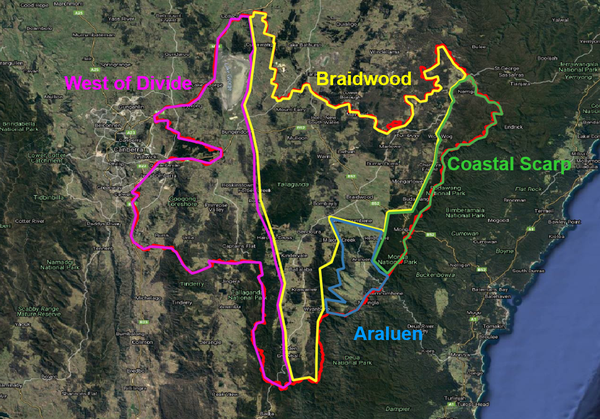Upper Shoalhaven Climate-Ready Revegetation Project
A 2021-2022 Upper Shoalhaven Landcare Council Landcare Led Bushfire Recovery project conducted by Mary Appleby and Melita Milner
The ravages of drought, fire and flood have made their presence felt over the past few years, with significant impact on life, landscape and native vegetation. Dieback and loss of tree cover are becoming more apparent. From the widespread death of Eucalyptus viminalis on the Monaro, to severe dieback of Eucalyptus blakelyi in the ACT, and a nationwide citizen science project from ‘Dead Tree Detectives’ mapping tree death and determining causes, the trend is increasingly clear.
One factor implicated in the rise of tree deaths across the country is climate change. Scientists are looking at ways to increase the resilience of trees and other vegetation in the face of a rapidly changing climate.
To build local understanding, the Upper Shoalhaven Landcare Council (USLC) commissioned a study to investigate the likely resilience of our local native trees and shrubs to projected climate change across our region. The project assessed how the species were likely to fare in the predicted far-future (2070) climate and examined strategies to increase resilience going forward.
Map of four climate subregions within the study area (roughly equivalent to Queanbeyan-Palerang Regional Council). Image Credit: M Milner and M Appleby
The current climate snapshot for our region in 2070 is predicted to be 2°C hotter on average. There will be more hot days and less cold nights. We can expect an average of 18 days above 35°C, and 35 fewer nights below 2°C. While rainfall is predicted to increase by 1.4%, seasonal changes mean there are likely to be deficits in winter and spring, with a marked increase in summer rainfall, alongside an increased probability of extreme events (flood, storms, drought).
The authors of the USLC study, Dr Melita Milner and Mary Appleby, assessed likely long term climate survival of 76 local tree and shrub species against this climate snapshot. Using data derived from NSW and ACT Regional Climate Modelling (NARCliM), they compared the current climate ‘envelope’ of each species (the range of temperature and rainfall across the current geographic distribution) with the predicted 2070 climate envelope.
The authors assessed species’ viability across four subregions - the Araluen Valley, Coastal Scarp, and areas west and east of the Divide - areas already displaying subtle differences in climate, geography and vegetation communities. The predicted climate change was assessed against species’ climate envelopes for each subregion, resulting in a list of suitable trees and shrubs, as well as recommendations for locations to source potential climate-ready seed.
Results seem sobering at first glance. Only 32 species (42%) were assessed as likely to tolerate the predicted 2070 climate, another 9 species (12%) were considered marginally tolerant, and 36 species (46%) were assessed as unlikely to tolerate these conditions, including many of our common eucalypts (64%).
While concerning, it is important to recognise that there are many other factors which influence species’ survival, including physiological tolerances of each species, landscape position, soil factors, and ecological interactions. For example, many plants, such as Cootamundra Wattle and Wollemi Pine have very limited distributions, and appear to have a narrow climatic range, but grow well in a wide range of conditions.
While ongoing revegetation projects should consider species more likely to tolerate future climate, the authors suggest it is important to monitor tree health and keep planting the range of native species that occur and do well here now to support local biodiversity.
As we head into an uncertain climate future, “the best bet is to source seed and other plant material from areas already experiencing conditions similar to the predicted climate for the district”, says Mary Appleby. The study found many species were already located in compatible climate envelopes scattered across north-northwest NSW. “By incorporating seed from these areas, we can increase the genetic diversity of local species, and their adaptive capacity to survive a changing climate” adds Melita.
Going forward, USLC plans to use the findings to source the necessary seed and begin propagating suitable climate-ready native tubestock for the district. Following in the footsteps of Yass Area Landcare Network, which already propagates a range of climate-ready seed in community nurseries, USLC’s goal is to build a volunteer-run nursery and grow plants to supply to local revegetation projects.
There are also things individuals can do. When purchasing native tubestock, ask where the seed has come from. Is it local provenance or from an area where the present climate is potentially similar or dissimilar to what’s expected for our region in 2070?
Ultimately, what’s clear from the work is that a landscape-level revegetation plan is needed, targeting long term species survival. Small changes in temperature, rainfall and the frequency of extreme climatic events could have big knock-on effects for a range of local trees and shrubs. Adopting climate-ready revegetation strategies now could equip our local plant communities with the ability to be more resilient decades down the track.







